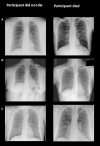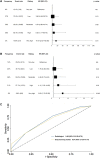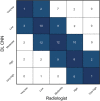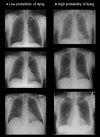Radiologists can visually predict mortality risk based on the gestalt of chest radiographs comparable to a deep learning network
- PMID: 34599265
- PMCID: PMC8486799
- DOI: 10.1038/s41598-021-99107-0
Radiologists can visually predict mortality risk based on the gestalt of chest radiographs comparable to a deep learning network
Abstract
Deep learning convolutional neural network (CNN) can predict mortality from chest radiographs, yet, it is unknown whether radiologists can perform the same task. Here, we investigate whether radiologists can visually assess image gestalt (defined as deviation from an unremarkable chest radiograph associated with the likelihood of 6-year mortality) of a chest radiograph to predict 6-year mortality. The assessment was validated in an independent testing dataset and compared to the performance of a CNN developed for mortality prediction. Results are reported for the testing dataset only (n = 100; age 62.5 ± 5.2; male 55%, event rate 50%). The probability of 6-year mortality based on image gestalt had high accuracy (AUC: 0.68 (95% CI 0.58-0.78), similar to that of the CNN (AUC: 0.67 (95% CI 0.57-0.77); p = 0.90). Patients with high/very high image gestalt ratings were significantly more likely to die when compared to those rated as very low (p ≤ 0.04). Assignment to risk categories was not explained by patient characteristics or traditional risk factors and imaging findings (p ≥ 0.2). In conclusion, assessing image gestalt on chest radiographs by radiologists renders high prognostic accuracy for the probability of mortality, similar to that of a specifically trained CNN. Further studies are warranted to confirm this concept and to determine potential clinical benefits.
© 2021. The Author(s).
Conflict of interest statement
Dr. Lu has common stock in NVIDIA and AMD. Dr. Lu reported research funding as a co-investigator to MGH from Kowa Company Limited and Medimmune/Astrazeneca and receiving personal fees from PQBypass unrelated to this work. Dr. Aerts reported receiving personal fees from Sphera, Genospace, and Onc.AI outside the submitted work. Dr. Hoffmann reported receiving research support on behalf of his institution from Duke University (Abbott), HeartFlow, Kowa Company Limited, and MedImmune/Astrazeneca; and receiving consulting fees from Duke University (NIH), and Recor Medical unrelated to this research. Dr. Taron reported speakers bureau of Siemens Healthineers. Dr. Taron and Dr. Weiss are funded by an unrestricted fund from the Deutsche Forschungsgemeinschaft (DFG, German Research Foundation; TA 1438/1-2 and WE 6405/2-1).
Figures





Similar articles
-
Deep Learning to Assess Long-term Mortality From Chest Radiographs.JAMA Netw Open. 2019 Jul 3;2(7):e197416. doi: 10.1001/jamanetworkopen.2019.7416. JAMA Netw Open. 2019. PMID: 31322692 Free PMC article.
-
Potential of deep learning in assessing pneumoconiosis depicted on digital chest radiography.Occup Environ Med. 2020 Sep;77(9):597-602. doi: 10.1136/oemed-2019-106386. Epub 2020 May 29. Occup Environ Med. 2020. PMID: 32471837
-
Deep learning to detect acute respiratory distress syndrome on chest radiographs: a retrospective study with external validation.Lancet Digit Health. 2021 Jun;3(6):e340-e348. doi: 10.1016/S2589-7500(21)00056-X. Epub 2021 Apr 20. Lancet Digit Health. 2021. PMID: 33893070 Free PMC article.
-
Deep Convolutional Neural Network-based Software Improves Radiologist Detection of Malignant Lung Nodules on Chest Radiographs.Radiology. 2020 Jan;294(1):199-209. doi: 10.1148/radiol.2019182465. Epub 2019 Nov 12. Radiology. 2020. PMID: 31714194
-
Optimal matrix size of chest radiographs for computer-aided detection on lung nodule or mass with deep learning.Eur Radiol. 2020 Sep;30(9):4943-4951. doi: 10.1007/s00330-020-06892-9. Epub 2020 Apr 29. Eur Radiol. 2020. PMID: 32350657
Cited by
-
Deep Learning With Radiomics for Disease Diagnosis and Treatment: Challenges and Potential.Front Oncol. 2022 Feb 17;12:773840. doi: 10.3389/fonc.2022.773840. eCollection 2022. Front Oncol. 2022. PMID: 35251962 Free PMC article. Review.
References
-
- ACR–SPR-STR Practice Parameter for the Performance of Chest Radiography 9.
Publication types
MeSH terms
LinkOut - more resources
Full Text Sources

